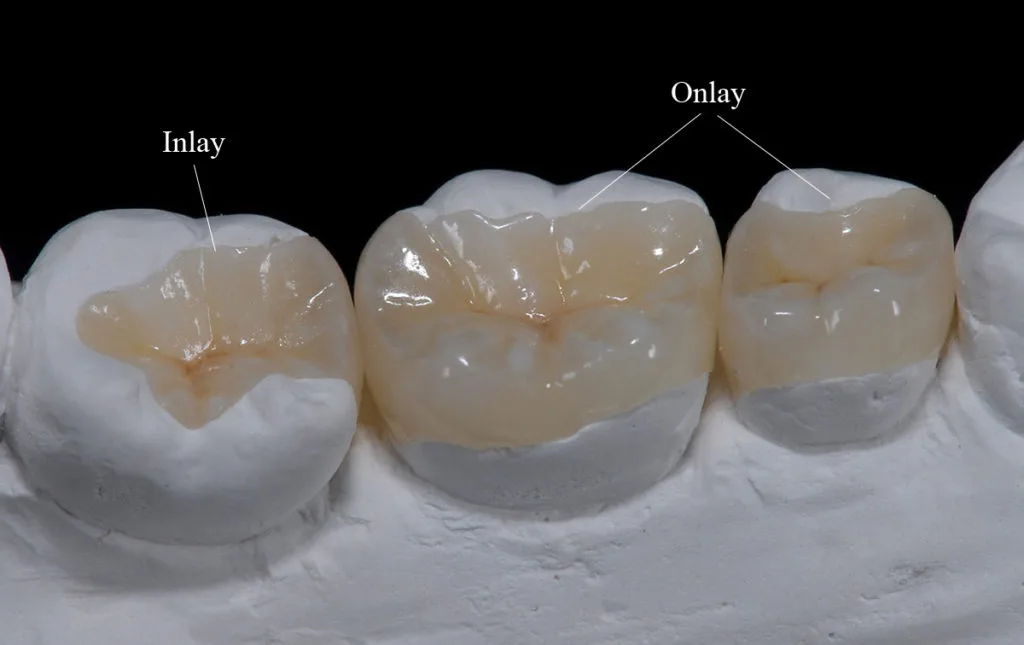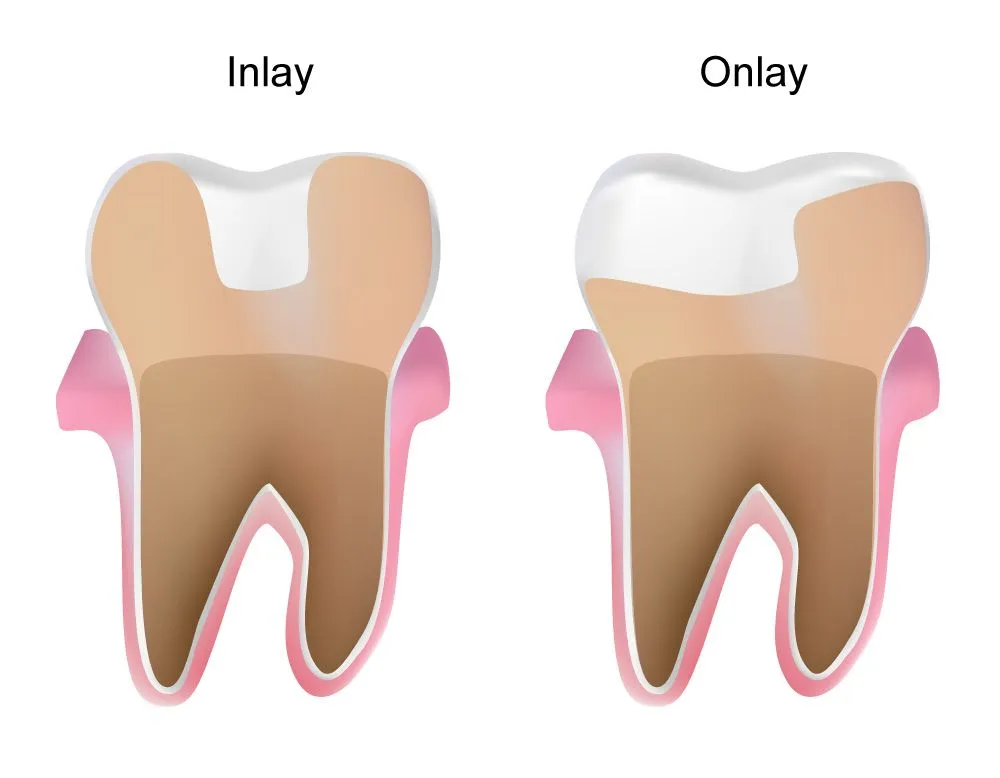Last Updated on: 11th June 2024, 07:42 am
✓ Fact Checked 🕓
❙ Our team of writers, editors, and medical experts rigorously evaluates each article to ensure the information is accurate and exclusively cites reputable sources.
❙ We regularly assess how the content in this article aligns with current scientific literature and expert recommendations in order to provide the most up-to-date research.
The use of dental restorations such as inlay vs. onlay becomes crucial to avoid compromising the tooth’s structure. In situations where dental caries significantly affects a tooth and generates damage that covers a wide area, it is not appropriate to treat it with a traditional filling.
Dental inlays are also a treatment option for enamel wear due to bruxism, fissures, small breaks, or dental fractures that do not affect the upper part of the tooth.
For proper care, there are two types of inlays as therapeutic options: inlays and onlays.
In 2002, the American Dental Association carried out a study to find out if dentists used amalgam for this type of intervention and found that only 54% of professionals opted for it. By 2005, one-third of dentists in the United States were no longer using it, while the other two-thirds reported that the material was being used less frequently.
Currently, dental inlays with different materials have gained acceptance due to the characteristics of the materials in which they are made and their many advantages.
What are Dental Inlays?

Dental inlays and onlays are restorations that rehabilitate teeth affected by caries. They are an alternative to traditional amalgam or composite resin fillings and are used as an option when the cavity in the tooth is too large, and a more extensive restoration is required to preserve tooth structure.
What is an Inlay?

It is a restorative alternative that allows the recovery of teeth damaged by caries that can no longer be treated with a simple or temporary filling.
The inlay is custom fabricated in a dental laboratory from materials such as ceramic, composite, or porcelain.
Two sessions with the dentist are required for placement. During the first, the caries and any consequent dental damage are removed. An impression of the affected tooth is taken and sent to the dental laboratory for the manufacture of the piece at the required size. A provisional inlay is placed to protect the tooth while the final one is being manufactured.
In the second session, the dentist removes the temporary inlay and places the permanent one. He checks that it fits the tooth and makes any necessary corrections. Finally, a strong dental adhesive is applied and polished to achieve a natural look and comfortable bite.
What is an Onlay?

It is a more extensive dental restoration option than an inlay, but smaller than a crown. It is used when the decay or injury affects a larger portion of the tooth, including the cusps.
They are also custom-made in a dental laboratory from ceramic, porcelain, or composite. The process of placing an onlay also requires two visits to the dentist.
In the first consultation, the caries and the affected dental tissue are removed. An accurate impression of the tooth is then taken and sent to the dental laboratory to fabricate the custom inlay. A temporary inlay is placed to protect the tooth while the final restoration is fabricated.
On the second visit, the temporary piece is removed and the permanent one is placed. The adjustment is verified and – if necessary – any required adjustments are made. Finally, a dental adhesive is applied, and they are polished to achieve a natural look without affecting the bite.
Differences Between Inlay vs. Onlay

Although they have similarities, there are also differences in scope.
An inlay is used when decay or dental injury primarily affects the inner surface of the tooth. It is placed on the inside of the tooth and makes it easy to restore the original form and function. The procedure involves removing the cavity and opening a space to place the inlay.
The only option is used when caries lesions affect a larger portion of the tooth, go beyond the internal surface of the tooth, and cover one or more affected cusps. It is necessary to remove caries and damaged dental tissue on the cusps, and open a space to place the piece.
The main difference between inlays and onlays lies in the restorative area. While an inlay is placed inside the tooth, an onlay covers and restores the damaged cusps, i.e., the outer part.
Advantages and Disadvantages of the Inlay Restoration
Dental inlays offer several advantages such as aesthetics, preservation of dental tissue, and ease of maintenance:
• Being custom-made, they adapt perfectly to the color and shape of the tooth, providing a natural appearance.
• They are made of ceramic or porcelain, materials that give them both resistance and durability.
• They are highly resistant to stains.
• They are aesthetically attractive.
• They are easy to maintain and do not wear out over time. They can be brushed and cleaned like natural teeth, which facilitates proper oral hygiene.
However, they also present disadvantages:
• The placement process is longer compared to other dental rehabilitation options.
• Tooth preparation may require the removal of more healthy tooth tissue. This is a relevant factor, especially in teeth with limited tooth structure or previous endodontic treatment.
• In general, they are more expensive than other alternatives since they are custom-made with high-quality materials.
Advantages and Disadvantages of Onlay Restoration
Onlays offer several advantages:
• Durability: they are made of resistant and high-quality materials; they support the pressure of chewing for several years.
• They facilitate the treatment of extensive dental damage. They can cover and restore areas most affected by cavities or fractures.
• They preserve as much healthy dental tissue as possible, maintaining the integrity and strength of the tooth.
You should also take into account some disadvantages:
• The cost: they tend to be more expensive than other options such as amalgam or composite resin fillings.
• The placement process requires two visits to the dentist.
Preparation for the Procedure

The procedure to obtain an inlay or onlay has different stages:
1. It is essential to make an assessment of the condition of the affected tooth and determine the best option.
2. Prepare the tooth by removing decay and any damaged dental tissue.
3. Take dental impressions with molding materials that allow for custom fabrication.
4. Place a temporary inlay to protect the tooth.
5. Place the permanent inlay.
6. Follow up and take care after the procedure.
The choice of the best treatment alternative is determined according to the level of the lesion that affects oral health.
After treatment, periodic check-up visits with the dentist should be made to assess the health and performance of the dental inlay.
Also, it is important to maintain good oral hygiene by brushing and flossing regularly.
It is also suggested to reduce sugar intake and avoid acidic, sticky, dairy, coffee, and dark fruit foods.
What is the Best Treatment Alternative?
In general, the procedure to obtain a dental inlay or onlay is simple and effective for restoring damaged or decayed teeth; they provide a durable and aesthetic solution.
Depending upon the magnitude of the lesion that affects oral health, the dentist determines the best therapeutic option to treat the corresponding case.
Frequently Asked Questions
What are the advantages of applying an onlay?
Applying an onlay offers several advantages. First, it strengthens the tooth that has undergone endodontic treatment, thereby reducing the possibility of cavities leaking. In addition, it provides improved dental aesthetics since it accurately reconstructs the original anatomy, color and shine of the tooth. Finally, it is important to highlight that when using an onlay, there is no risk of root fracture.
What is the meaning of inlays and onlays?
Inlays and onlays are terms used in the field of dental aesthetics to refer to certain types of dental inlays. These inlays, also known as overlays, are mainly used on the back teeth of the mouth, that is, on the premolars and molars to treat cavities of different sizes.
What is the duration of a dental inlay?
The duration of a dental inlay cannot be exactly determined since it depends upon several factors. However, they generally have a durability of between 5 and 25 years. The presence of caries and fractures are the main factors that can shorten the useful life of inlays.
What happens if an inlay falls off?
When an inlay falls off and is not replaced: food can accumulate in the empty space. The area lacks dental enamel and is more susceptible to external aggression. There is a greater facility for the development of caries in a particular tooth.
Share:
References
1. Jackson Ron (2012) Esthetic Inlays and Onlays / https://www.sciencedirect.com/sdfe/pdf/download/eid/3-s2.0-B9780323068956000177/first-page-pdf
2. Sheet Maria del Mar (2016). Endodontic restoration of posterior teeth: inlays and onlays. Degree work – University of Seville / https://idus.us.es/bitstream/handle/11441/62114/TFG%20M%C2%AA%20del%20Mar%20Pliego%20G%C3%B3mez.pdf?sequence=1
3. Senatore Sabrina (2021) Inlays, types of preparation and materials, advantages and disadvantages / https://titula.universidadeuropea.com/bitstream/handle/20.500.12880/553/77.pdf?sequence=1&isAllowed=y
4. Sugue Mara (Mayo 19 de 2023) Dental Inlays and Onlays / https://www.newmouth.com/dentistry/restorative/inlays-onlays/













